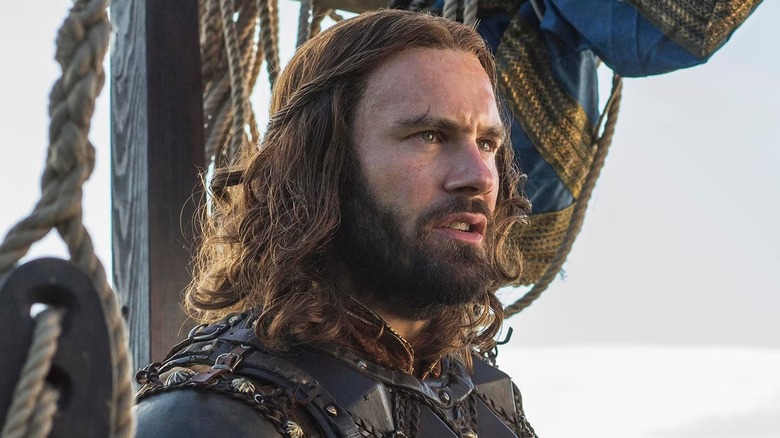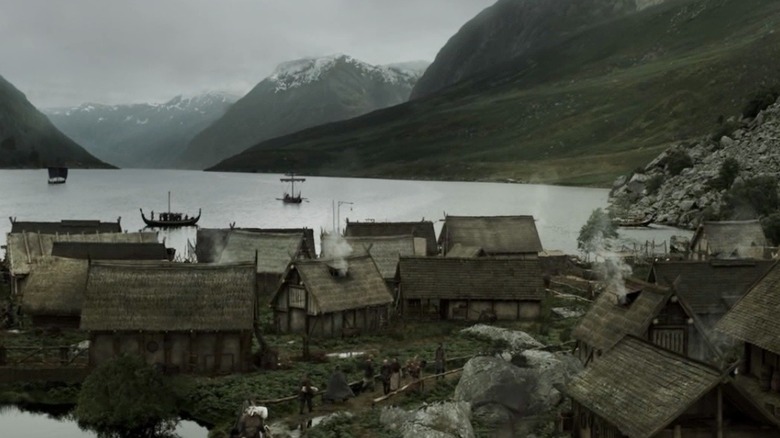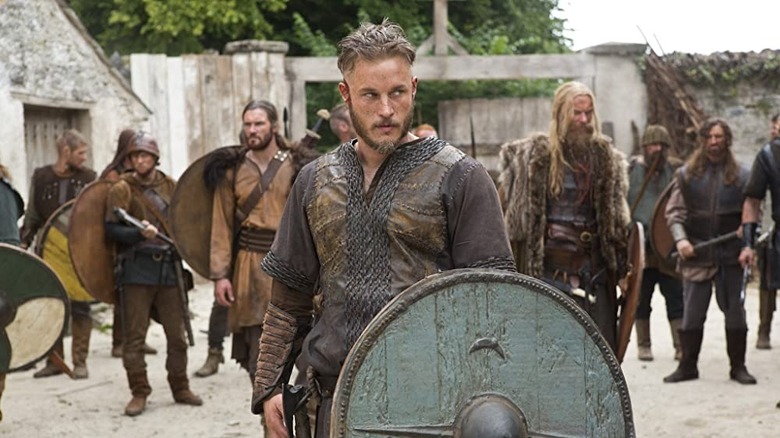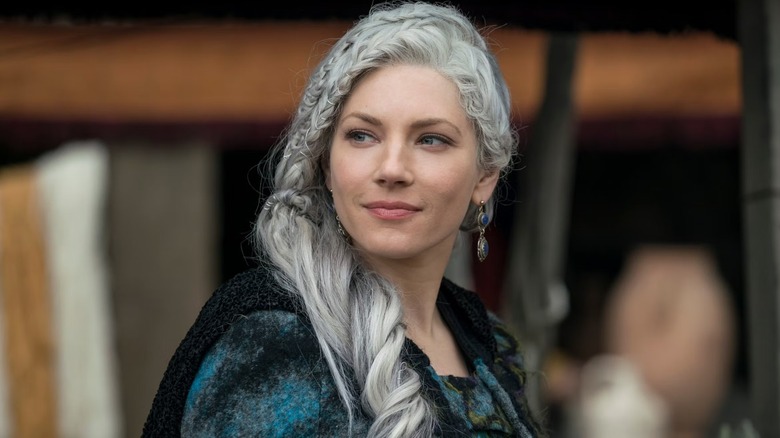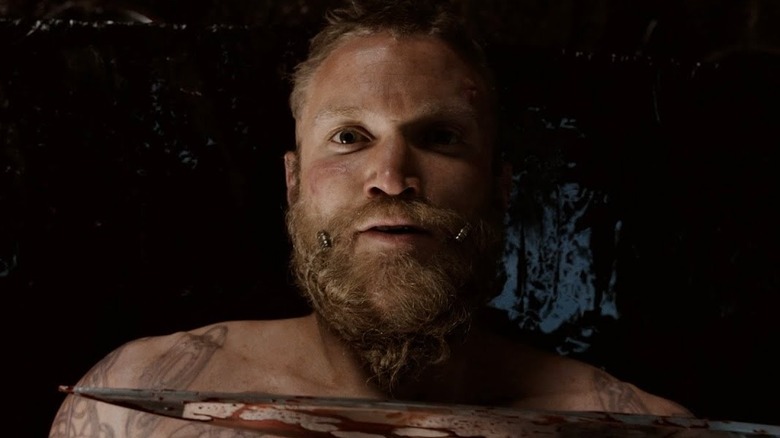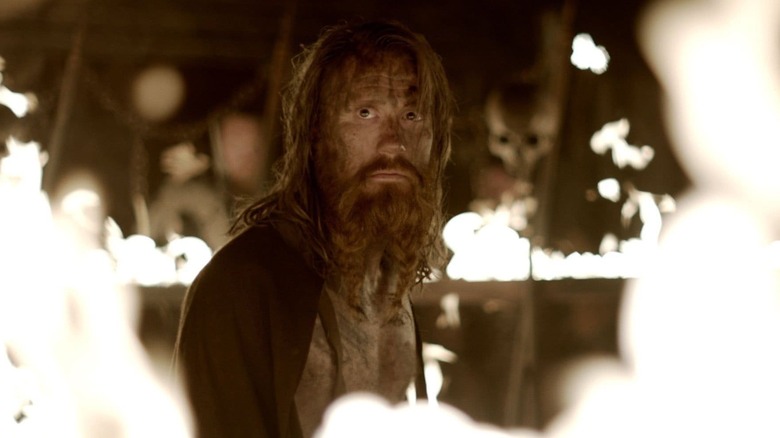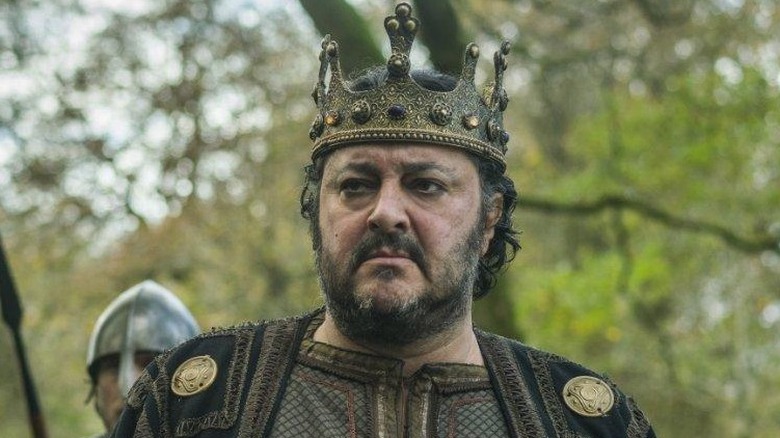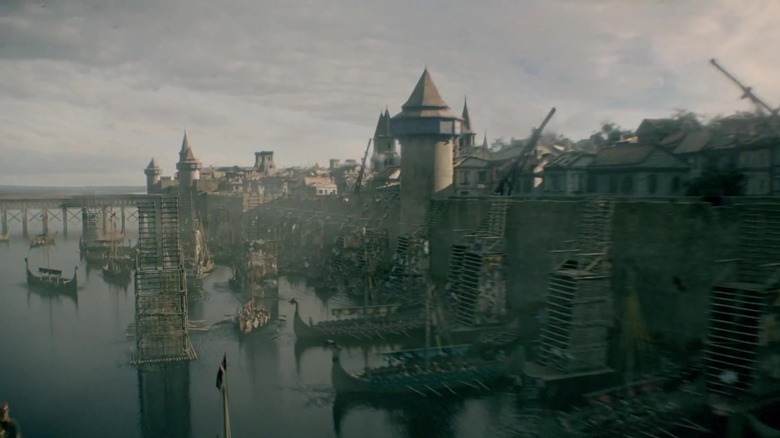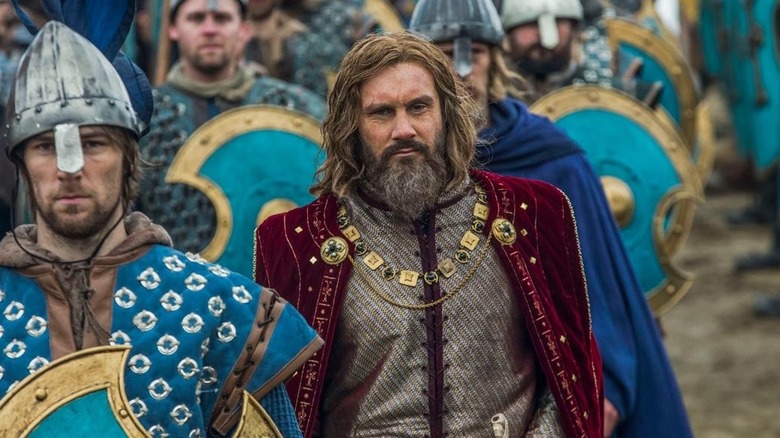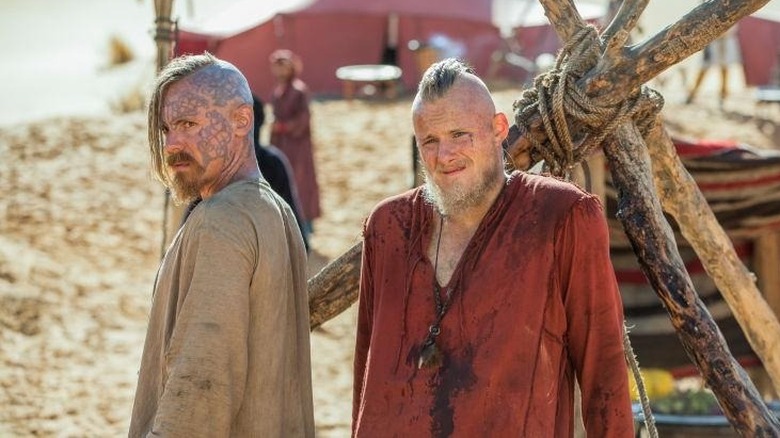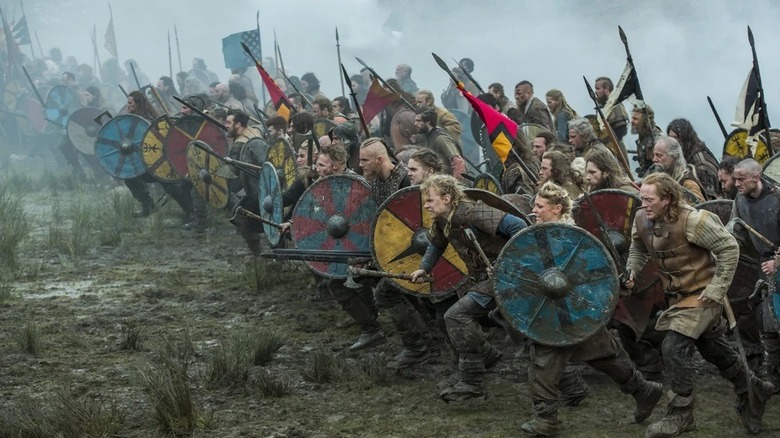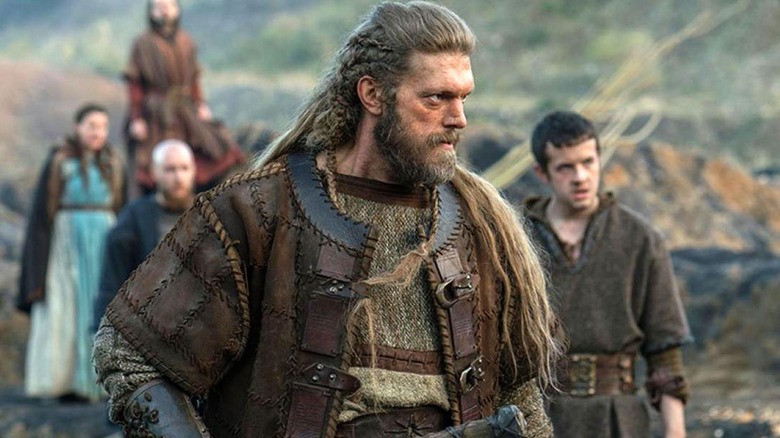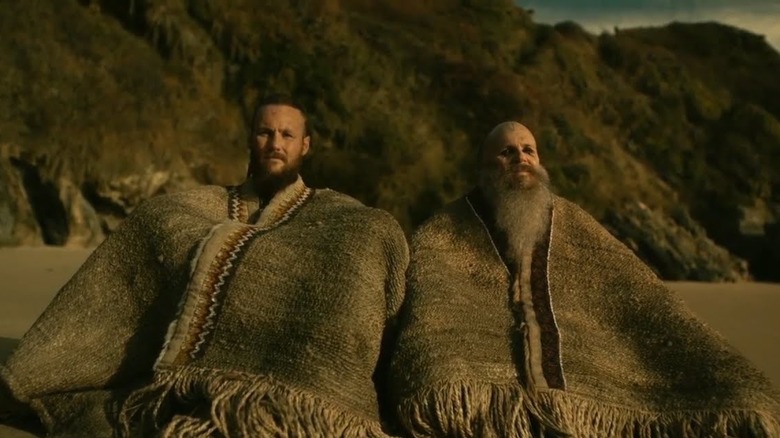The Real Story Behind History Channel's Vikings
The Vikings lived in a time of expanding maps and boundless adventure. To them, gods and monsters were living, breathing beings whose thoughts and actions directly influenced the mortal world. It's an era brought to life in History's "Vikings," a gripping historical drama with lots of violence, elements of fantasy, and a few Viking love triangles. But how much of the series is grounded in truth?
The exploits of the Vikings were chronicled in Norse sagas passed down for more than a thousand years, but historians face the daunting challenge of untangling legend and myth from fact. Fortunately for them, when the Norse people took to the seas and staked claims throughout Europe and beyond, they left their mark on everyone they encountered. This means that many of the events outlined in the sagas were also recorded in works like the Anglo-Saxon Chronicle, a collection of medieval records beginning with the reign of King Alfred the Great of Wessex.
Watching History's "Vikings" won't earn anyone an A grade in history. However, taken with a pinch of salt, it's not a bad introduction to the Viking worldview and some of the political changes at play in Europe during the Middle Ages. Read on if you want to know more about the real history behind Ragnar Lothbrok and the world he lived in.
Kattegat
In the world of "Vikings," Kattegat is the seat of power for the Viking people and where King Ragnar's throne lies. Over the course of the series, it grows from a harbor town with a marketplace to a thriving multicultural community and port city. By the time of sequel series "Vikings: Valhalla," Kattegat's marketplace is bustling with merchants from lands far and wide.
While Kattegat plays a key role in the Lothbrok family's rise to power, the community itself was dreamed up for the show. Although Kattegat is a real geographical location, it's not a medieval Viking city, but a shallow strait between the North Sea and the Baltic Sea. It's located roughly between Sweden and Denmark. Along with many of the show's locations, the fictional Kattegat was filmed in Ireland, which boasts stunning scenery that mirrors Scandinavia. "Within a very short range of the studio, you have mountains, woods, lochs, and the sea — very important in a Viking show," creator Michael Hirst said in a behind-the-scenes featurette.
Perhaps the closest real-world version of Kattegat was called Nidaros, the capital of Norway during the Viking Age. The famous Viking king Olav Haraldsson, who was made a saint after his death due to his role in bringing the Christian faith to Norway, was buried in Nidaros, which goes by the name Trondheim today.
Early Viking raids
In History's "Vikings," Ragnar Lothbrok conducts his first English raid in 793 after sailing west without Earl Haraldson's permission. Upon arriving, the Norsemen find themselves at Lindisfarne, Northumbria (aka Holy Island), where they encounter a monastery filled with terrified monks, mercilessly killing all but one of them despite facing no resistance. The event lines up with a historical record recounted in the Anglo-Saxon Chronicle.
According to the Anglo-Saxon Chronicle, the year 793 brought "dreadful fore-warnings over the land of the Northumbrians, terrifying the people most woefully." Regarding the raid, it states that "harrowing inroads of heathen men made lamentable havoc in the church of God in Holy-island, by rapine and slaughter." The Northumbrian scholar Alcuin, who was living in the court of the Frankish king Charlemagne at the time, would later describe the sacking in a series of letters. He said that the monastery was "spattered with the blood of the priests of God" and that the Norse invaders "trampled on the bodies of saints in the temple of God, like dung in the street."
The Anglo-Saxon Chronicle says that the Viking raid took place "on the sixth day before the ides of January," though modern scholars believe this was an error and that it actually happened in June of that year. Although this was the first recorded monastery sacking, the first recorded Viking raid was actually in 787. According to the Latin text The Chronicle of Æthelweard, three Viking ships came ashore near Dorchester and the Norsemen killed a local reeve (an early form of sheriff) named Beaduheard.
Viking fashion
Although popular culture has long depicted Vikings as horned helmet-wearing stereotypes, that trope actually originated in the 19th century and has never been supported by archaeological findings from the period. While the Norse folk of History's "Vikings" aren't rocking horned hats, they do make some pretty strong fashion statements, from heavy black eyeliner to elaborate braids.
Because the Vikings cremated their dead, archaeologists don't have a complete record of medieval Viking attire. However, they've been able to make educated guesses by applying a modern understanding of period technologies and trading practices based on contemporary accounts from Europeans who encountered them. Vikings were farmers first and foremost, so medieval Vikings likely wore soft woolen clothing appropriate for their daily responsibilities. Scholars believe they used bright dyes derived from plants to change the color of their clothing, and some say that kohl was likely used as eyeliner. Wealthier Vikings adorned their outer layers with brocade, and religious amulets were common, especially Thor's hammer.
Although the braids in "Vikings" were dreamed up by hair guru Dee Corcoran, evidence suggests that some Vikings — especially the women — adopted this hairstyle. Men were known to shave the backs of their heads while keeping the front long, and this style was apparently adopted by some in the British Isles. In a letter from the time, an Englishman criticized his brother for looking like a Viking, writing: "You dress yourself in the Danish fashion, with bald neck and blinded eyes." Versions of this so-called reverse mullet are rocked by Bjorn Ironside and Halfdan the Black in the show.
Human sacrifice
As recounted in Hakon the Good's Saga, blood sacrifices were seemingly an important part of the pagan belief system. In "Vikings," the Norse people consider Uppsala to be a holy site, often gathering there to worship and sacrifice animals in a plea to the gods. The real temple at Uppsala was likely just as important a place to the real Vikings. Medieval writer Adam of Bremen described the temple as a building furnished with gold while recounting the statues of pagan gods, including Thor and Odin.
According to Adam, animals weren't the only things being sacrificed at Uppsala. "The sacrifice is as follows; of every kind of male creature, nine victims are offered," he wrote. "By the blood of these creatures, it is the custom to appease the gods. Their bodies, moreover, are hanged in a grove which is adjacent to the temple. This grove is so sacred to the people that the separate trees in it are believed to be holy because of the death or putrefaction of the sacrificial victims. There even dogs and horses hang beside human beings."
Historians have cast doubt on Adam's claims, as he was not present during the ceremony he describes and, as a Christian cleric writing for the benefit of Rome, he had a vested interest in making pagans seem barbaric. However, other evidence of human sacrifice during the Viking Age exists. One of the most important archaeological findings supporting this claim is a trio of sacrificial wells located at a Viking fortress dating back to the 10th century. Found in Trelleborg, Denmark, the ritual wells are believed to have belonged to wealthier Vikings. Inside the wells, archaeologists found a goat, a horse, a cow, a dog, and the skeletons of four children.
Blood eagle
The following entry contains mentions of extreme violence and mutilation.
No matter how much we might end up rooting for Lagertha and Ragnar, there's no doubt that the Kattegat crew is a violent one, whether they're on the battlefield, conducting raids, or dealing with Nordic political conflicts. As Jarl Borg learns the hard way, no Viking custom is more brutal than the blood eagle. This gruesome execution ritual sees its living victim sliced apart to create "wings" from their ribs, as depicted in "Vikings" Season 2. The gory act is not the product of an envelope-pushing screenwriter's imagination but instead pulled straight from the Norse sagas.
The Orkneyinga saga describes the blood eagle as being performed for Odin as a sacrifice of thanks. Halfdan Long-Leg (the son of Harald Finehair) was the victim. Another famous recipient of the blood eagle is King Ælla of Northumbria, who gets sentenced to this fate by Ragnar's sons in "Vikings." This is based on the saga Tale of Ragnar's Sons, in which Ivar the Boneless takes revenge in the name of his late father, who was tossed into a pit of snakes by Ælla (an event also shown in the series). The saga states: "They now had the eagle cut in Ælla's back, then all his ribs severed from the backbone with a sword, in such a way that his lungs were pulled out there."
Scholars have long debated whether the blood eagle was actually performed. Some say it was done after the victim was dead as a scare tactic, while others believe it to be a fabrication. "As a whole, the pagan references feel a little explicit, the 'otherness' of the Vikings too evident," medievalist Matt Firth said. "Given the saga authors wrote in a Christian era, it reads a little as a Christian author's imagining of how he believed pagan Vikings would have acted."
The kingdoms of England
As portrayed in "Vikings," medieval Europe was a world of many rulers with shifting alliances who were regularly engaged in power struggles and border disputes. Keen to understand Britain, Ragnar asks captive Northumbrian monk Athelstan to explain the situation. He reveals that the island is made up of four kingdoms: Northumbria, Wessex, Mercia, and East Anglia. Originally a heptarchy, by the time of Ragnar's rule (in the show, that is — remember, Ragnar is a composite figure who may not have existed at all), England's seven Anglo-Saxon kingdoms had been consolidated down to only four. This period in English history is documented in the Anglo-Saxon Chronicle. King Ecbert (or Egbert) of Wessex and his rise to power is covered, as well as many of the four kingdoms' encounters with the Norse raiding parties.
"Vikings" features many of these figures and events, although the dates, chronology, and familial relationships get switched around somewhat for the purpose of storytelling. For example, while the succession crisis depicted after Offa of Mercia's death really happened, the real Kwenthrith (a woman named Cynethryth) was his queen, not his daughter. That being said, the show never strays too far from the truth. "Of course it's the Dark Ages, we know very little about the Vikings in the sense that they didn't write anything down, and what was written down about them was written by their enemies," creator Michael Hirst told Collider. "I'm very proud of the fact that it's a show that is real, and it's real in the sense it's based on real people, on real things."
The siege of Paris
Not long after he first sails west, Ragnar learns about Paris, a walled city described in almost mythical terms by Athelstan. Although Ragnar's siege of Paris takes place much earlier in the "Vikings" timeline, it is very much based on historical events.
Vikings first began raiding in Frankia in 799, when the famed king Charlemagne the Great was in charge. After his death, the region became increasingly unstable and the Norsemen took advantage. The cities of Rouen and Nantes were targeted before the Vikings set their sights on Paris. In 845, a huge force sailed up the River Seine to the rich island city and laid siege to it. Accounts attribute the siege to a Viking chieftain named Reginheri or Reginherus, who scholars believe to be the Ragnar of legend.
According to Norse sagas and Frankish chronicles, the Viking fleet boasted a whopping 120 ships, containing thousands of battled-hardened warriors. The Viking forces were diminished when a plague struck their camp, an event they believed to be supernatural in nature. In the end, the invaders were paid off with gold and silver — they were offered 7,000 livres to end the siege, a handsome amount.
The Vikings returned several times in the 860s, receiving yet more payments. When they came back again in the 880s, Duke Odo — who had been entrusted with the defense of Paris — was ready for them. He had erected towers on both banks of the Seine and used a boiling-hot compound of pitch and wax to repel those who attempted to climb the walls. The Vikings made a final attempt to take Paris in the summer of 886, but were unsuccessful. Odo was dubbed the "Savior of Paris" and was made King of the West Franks a few years later.
Duke Rollo
During Ragnar's rise to power, his troubled relationship with his older brother Rollo becomes increasingly strained. Rollo simmers with jealousy as he watches his younger brother live his best life with his dream shieldmaiden Lagertha. As Ragnar's risks start to pay off, Rollo succumbs to self-pity, but even in the depths of his despair, the Seer predicts big things for Rollo's future. It's a prophecy that comes to fruition when Rollo turns on his brother, aiding the Franks in their fight against Ragnar in exchange for land and power. While reconceptualizing him as Ragnar's brother makes for some pretty riveting television, the real Rollo actually ruled over his territory of Normandy several decades after Ragnar's legendary adventures.
Rollo (whose name is thought to be a Latinization of the Old Norse "Hrólfr") began raiding in Frankia after being expelled from his homeland, said to be either Norway or Denmark. He was forced to leave after plundering a district that belonged to the king. It was Rollo who laid siege to Paris in the 880s, locking horns with Odo. Part of the reason the siege came to an end is that Rollo was offered his own land if he agreed to help the Franks fend off further Viking incursions. He was also given the hand of Charles' likely daughter Gisla. Unlike the Gisla (or Gisela) depicted in "Vikings," scholars suggest the real princess would have been a young child when she was betrothed to Rollo, a common practice during the medieval period when arranged marriages were the standard.
Mediterranean and African raids
When Ragnar's raiding heyday winds down, his sons are more than happy to take over the family business. And for Björn, that means sailing even further south to the Mediterranean. In preparation for the raid, Floki designs his best ships yet. Once ready, the Vikings travel along the Seine to Rollo, who joins them along with Hvitserk, Floki, Helga, Halfdan, King Harald, and around 1,500 warriors. The adventure leads them to the Spanish city of Algeciras, where they terrorize the community's Moorish residents and first encounter the Islamic faith.
Like their History Channel counterparts, the real Vikings wrought terror on communities throughout the Iberian peninsula, with Algeciras just one of the Mediterranean cities they raided. The Spanish town of Catoira still commemorates the encounters today with an annual festival that includes a reenactment of the raid and culminates in a party where octopus, mussels, and wine are on the menu.
The Vikings' 9th-century Iberian peninsula activities are well-documented in both Nordic and Islamic sources. Evidence of the incursions can still be found in the area today, like the Viking anchors that washed ashore after a 2014 storm. As depicted in "Vikings," the medieval peninsula was populated by Muslims living under the Umayyad Emirate of Córdoba, an early Islamic kingdom. Vikings continued heading south from Spain, even raiding places in North Africa — they are known to have attacked the city of Nekor in present day Morocco for over a week during the 860s. The invaders reportedly captured the daughters of an Emir, who paid a ransom to secure their release.
The Great Heathen Army
In "Vikings," the English monarchs get a full taste of the Viking experience when the sons of Ragnar unite every Viking nation in a revenge tour on a scale hitherto unimagined. After learning of Ragnar's death, thousands of Scandinavia's warriors begin flocking to Kattegat, uniting under the leadership of Ivar and Björn. They travel to Northumbria, taking King Ælla by surprise before moving on to raid Mercia, Repton, and York, occupying land to set themselves up for future raids.
Called the Great Heathen Army in the Anglo-Saxon Chronicle, the formidable coalition came together under a raven symbol called the hrafnsmerki. After a few decades of hitting monasteries and other wealthy raiding targets, three of Ragnar's sons united Vikings from across Scandinavia in an effort to occupy the Anglo-Saxon kingdoms.
The on-screen army's leadership includes Ragnar's sons Björn, Ivar, Hvitserk, Ubbe, and Sigurd, along with Halfdan and King Harald. Although it's difficult to sort fact from fiction since medieval chroniclers weren't always the most reliable narrators, the real heathen army is said to have been led by Ivar, Ubbe, and Halfdan — who, unlike the antagonistic Halfdan of History's "Vikings," is said to have been one of Ragnar's sons. According to the saga Tale of Ragnar's Sons, revenge was the impetus for the invasion, which was actually a years-long occupation rather than a one-off tour.
Discovery of Greenland
Although many of the events portrayed in "Vikings" loosely line up with real historical events, the show takes considerable liberties with the Norsemen's discovery of Greenland. Not long after Floki discovers Iceland, Ubbe and Torvi end up in a barren wasteland they ironically dub Greenland, a name suggested by Kjetill Flatnose – "How else are we going to attract new settlers?" he says. In reality, Vikings first settled the world's largest island during the late 10th century, somewhat later than depicted in the History series.
It's said that the first Viking to lay eyes on the modern territory of Greenland was a Norwegian named Gunnbjörn Ulfsson, who observed a handful of small islands now known as Gunnbjörn's Skerries after his ship was blown off-course en route to Iceland. Realizing that this was not Iceland, he turned back. The mainland would later be settled by Erik Thorvaldsson, known more commonly as Erik the Red.
Erik had been exiled from Norway for murder, and was later banned from Iceland for the same crime for a period of three years. After hearing about Gunnbjörn's Skerries, Erik set sail for Greenland to make a new home for himself, as recounted in Saga of Erik the Red. It was Erik who decided to call the place Greenland in order to attract more settlers, not Ubbe and Kjetill. Erik's story is woven into "Vikings: Valhalla" through the tale of his children Leif Erikson and Freydís Eiríksdóttir.
The Golden Lands
After their discovery of Greenland, Ubbe, Torvi, and a small band of bold would-be settlers continue their quest for the fabled Golden Lands supposedly glimpsed by Othere. They're on the brink of death when they find it. The travelers encounter the Native Miꞌkmaq and the believed-to-be-dead Floki, but relations become strained after the greedy Naad kills a Mi'kmaq youth. Ubbe ensures justice by executing him for the murder. But did Vikings really make it to America?
Historians now believe that Leif Erikson was the first European to set foot on the North American continent, arriving almost 500 years before Christopher Columbus. He wintered in a place called Vinland, known today as Newfoundland, but didn't settle there. Although Saga of the Greenlanders and Saga of Erik the Red both discuss Viking settlements in North America, these accounts were called into question — that is, until the 1960s, when a Norwegian couple finally uncovered definitive proof of the claims.
Using clues from the sagas as their guide, explorer Helge Ingstad and his wife, archaeologist Anne Stine, set out on their own real-life treasure hunt. The journey brought the couple to Newfoundland's Great Northern Peninsula, where they found mounds locals believed to be Indigenous located in L'Anse aux Meadows. Excavations revealed what experts believe to be a temporary Norse ship repair settlement dating to around 1021. The settlement's buildings include a chieftain's hall, several other living quarters, an iron smelting workshop, and a storeroom.
